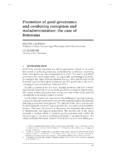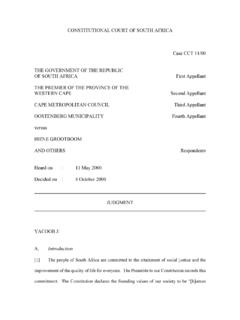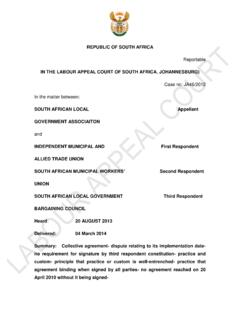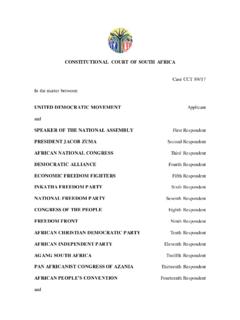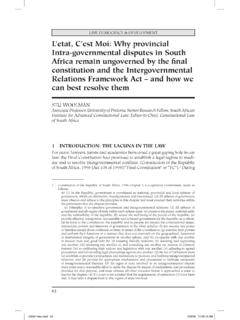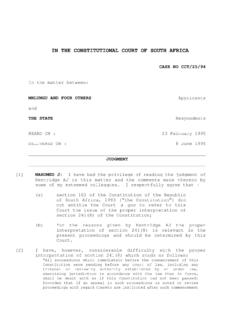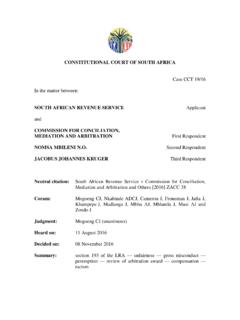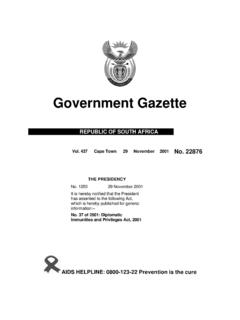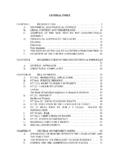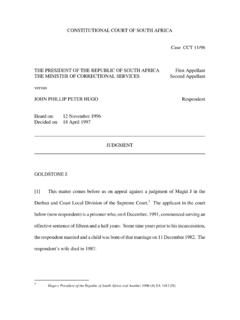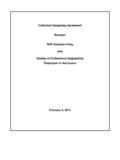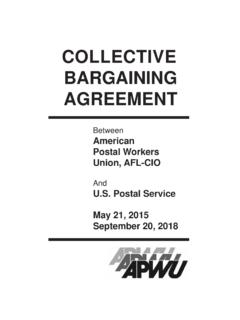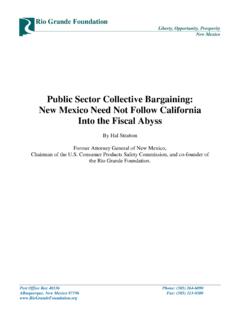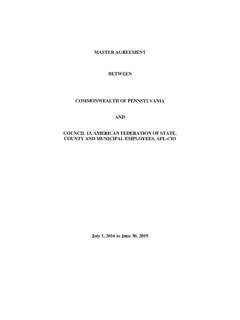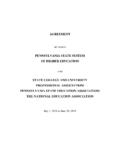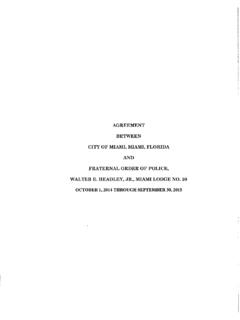Transcription of Collective bargaining and the LRA - SAFLII Home
1 Collective bargaining and the LRA HALTON CHEADLE Professor of Law, University of Cape Town INTRODUCTION This paper seeks to explore three areas -all of which are pertinent to a. (0 year review of Collective bargaining under the Labour Relations ACl r"LRA"j.' These areas are: The right to bargain collectively: The constitutional attack on the extension of Collective agreements; The current state of sector level bargaining . 2 THE RIGHT TO BARGAIN COLLECTIVELY IN THE LRA The right to bargain collectively is shorthand for a range of rights and free-doms associated with the institution of Collective bargaining . Each of these rights and freedoms need to be distinguished: There is the freedom to bargain collectively -this is a negative right. It is a right normally raised against a government passing legislation pro-hibiting Collective bargaining or having the effect of doing so.)
2 " There;s the right to use Collective economic power in pursuit of a demand;3 There is the positive right with the concomitant duty to bargain -a. stare enforced duty to bargain. The compulsion normally takes the form of a judicially enforced duty to bargain. This is the model used in the US, Canada and Japan. It was also adopted by the Industrial Court under its broad unfair labour practice jurisdiction under the old LRA.; The LRA gives effect to all three elements of the right to bargain. ]( gives effect to the freedom to bargain collectively by providing the institutional infrastructure for voluntary Collective bargaining at sector level and for the binding nature of Collective agreements. It gives effect to the right to usc Collective economic power in the provisions relating to strikes, lockouts, I 66 of J 995 which came into operation on J 1 November! 996. 2 See Reference re PubUe Service Employee Relations Ad ([ 987) 18 (4Ih) 161 3 See fn re Certification qf the Constitution oj the Hqwblic of SA.)
3 1996 [946 (I U) BCLR 1253 & ([ 996) 17 [253 (ee). ColleClivc bargaining ilTlplil:s a right on the part of those who crlgage ill Collective lJdrgairlillg to exercise economic power against their advers-aries .. Once a right to Collective bargaining is recogniscd. implicil wittiin it will be the right co exercise some economic power agairisl partllers ill Collective : bargaining ' lat para 61]. 4 28 of 1956 147 LAW, DEMOCRACY &. DEVELOPMENT replacement labour and picketing. And it imposes a positive right and structure to bargain collectively in the public sector. But it does not do so in respect of the private sector. Although trade unions and employers and their associations in the pri~ vate sector are free (Q determine the levels and structure of Collective bar-gaining, the LRA clearly promotes sector level bargaining as the preferred level. It does so for the following reasons: Sector level bargaining is low on transactional costs.)]]
4 The negotiations are conducted by representative organisations; Sector level bargaining shifts Collective bargaining on the major issues out of the workplace, with that workplace relations are less strained; bargaining outcomes are general in nature allowing for variation at the level of the workplace; Sector level bargaining sets a social floor for competition. By setting reasonable standards applicable to all employers in the local market, competition between those employers is based on productivity rather than socially undesirable wages or extension of hours; Strikes and lockouts take place less frequently at sector level and are generally less damaging to individual employers because competitors in the local market are also subject to the strike; Labour mobility and economies of scale make sector wide benefit schemes desirable. The concern that voluntarism may allow employers ro refuse to bargain at all is met to some extent by the organisational rights accorded to trade unions in Chapter III of the LRA~ and the proVision of a statutory dispute resolution procedure.
5 The LRA's approach is to provide (he organisational infrastructure for union organisation at the workplace and to provide a conciliation procedure to resolve interest disputes irrespective of whether the trade union is recognised. 3 THE RIGHT TO BARGAIN IN THE CONSTITUTION Section 23(5) of the Constitution confers the right 'to engage in Collective bargaining ". That phrase has been the subject of contending interpret-ations in the Transvaal Provincial Division of the High Court -two cases' in favour of interpreting it as imposing a duty to bargain and one case 5 See Pari A ss I I 22. both inclusive 6 'Every trade union, employers' organisation and employer has the right to engage in colleclive bargaining . Nalional legislation may be enactet1 ro regulate Collective bargain-ing. To Ihe extent Ihal legislation may limi( 1I right in (his Chapler [he limilalion must comply with seclion 36t1)'.))]
6 7 SANDU v Minister of Defence & others (J) 2003 (9) BCLH J 055 [2003J 9 932 (2003) 24 IL} 2 J OJ & [20031 3 All SA 436 (T); SANDU v Minister of Defence & others (4) Unre-ported. TPD (Bertelsman J). 8 SANnU v Minister of nefence &: others (2) 2003 0) SA 239. (2003) 24 IL} 1495 (T). 148 Collective bargaining AND THE LRA In the first case concerning the South African National Defence Union v Minister of Defence & another (1),~ the Constitucional Court held that sol-diers were akin to employees and accordingly workers for (he purposes of section 23 of the Constitution. o Accordingly provisions in the Defence Actll and its regulations. which prohibited soldiers from belonging La trade unions and from engaging in public protests, were declared [Q be invalid. In response the Minister promulgated a set of regulations that provided for the registration and recognition of trade unions and (hat established a 'Military bargaining Council' and a 'Military Arbitration Board' for the res-olution of disputes.)]]]
7 I. In a nutshell, the regulations established a Collective bargaining struc-ture and process for the Defence Force. That structure and process, how-ever, did not permit soldiers to strike. SANOU, a trade union organising soldiers, was registered in (erms of the regulations and subsequently admitted to the Military bargaining Council. The proceedings of the Council did not progress smoothly. There were disputes over procedure, the agenda and the nature and scope of the bar-gaining process, particularly over policy. The union accused the Depart-ment of Defence of bad faith bargaining , in particular the use of un-acceptable tactics such as delays, misrepresentations and negotiating without a mandate. The Department accused the trade union of being aggressive. It created unrealistic expectations among its members and threatened labour unrest when those expectations were not met.)
8 In particular, the trade union resorted to scathing and insulting personal attacks on the Department's Collective bargaining representatives. Re-lations degenerated, the trade union threatened industrial action and the Minister suspended participation on the bargaining Council. This precipitated the first of the duty to bargain ; The union sought to compel the Minister and the Department to bargain with it in good faith relying on section 23(5)"~ and arguing that it conferred a consti-tutional duty to bargain, which the Minister and the Department had violated In the first application," the High Court declined to hold that section 23(5) conferred a duty to bargain. The trade union subsequently brought several further applications based on the same legal claim but on different factual bases. These applications culminated In two judgments both hold-ing section 23(5) to confer a constitutional duty to bargain, All three cases are on appeal to the Supreme Court of Appeal.
9 <) 19<)9 (6) lK!.H 6 [5. 1999 (4) SA 469 & ([ 99Y) 20 ILf 2265 (C). [0 Constitution of the Republic ot" SOUiIl Africd [OR of [99b [[ Act 44 of [957 subseqlJl!nlly repeClfed by section 106 of Ille Defence Ace 42 of 2002, excl!pl for section [04 i'lnd lhe FirSl Schedule, being lhe Military Disciplinary (ode [2 See also section 55 of lhe Detence Act 12 ot 2002 which carne in([J operaliorl on 2 JlHle 200" I) See fI 8 dbuve 14 (onsrilurion of the Republic of Soulh Africa 10K of [99b I 5 Sec n 8 atmvc. 149 LAW, DEMOCRACY & DEVELOPMENT The reasoning engaged in all three cases turned on the text of section 23(5)." Judges Smit and Bertelsmann held in SANDU (3) and (4/' respect-ively, that the text of section 23(5) clearly imposed a duty to bargain. Judge Van der Westhuizen in SANDU (2)" held that the diFference in word-ing between section 23(5) -'the right to engage in Collective bargaining ' -and its predecessor in section 27(3)'" -'the right to bargain collectively' pointed to a distinction between a Freedom and a right.)]]]]]]]]]]]]
10 The Court relied on 'academic authority,20 to support that conclusion. That academic auth~ ority relied primarily on a textual analysis of the section and the voluntar-ism espoused by the [ Given the strong reliance on the I LO Conventions by the Constitutional Court in two recent cases,22 the High Court could have made more of pub-lic international law and the !LO Conventions on Freedom of Association and Collective bargaining to support the court's conclusjon,n There are other arguments not referred to in the Court's decision that support its conclusion. The first argument is that a positive right to bargain is not just a right -it is a policy regime that involves fundamental choices as to the Form and level of Collective bargaining . It commits a labour market to a Collective bargaining regime centred on the workplace rather than at the level of in-dustry. It reqUires a regulatory regime that reqUires court or tribunal deter-mination of - who must bargain with whom -the threshold issues of representative-ness; the bargaining constituency or unit; what may be bargained about ~ bargaining subjects: and the manner in which bargaining takes place ( bargaining in good faith and the duty of Fair representation).]
